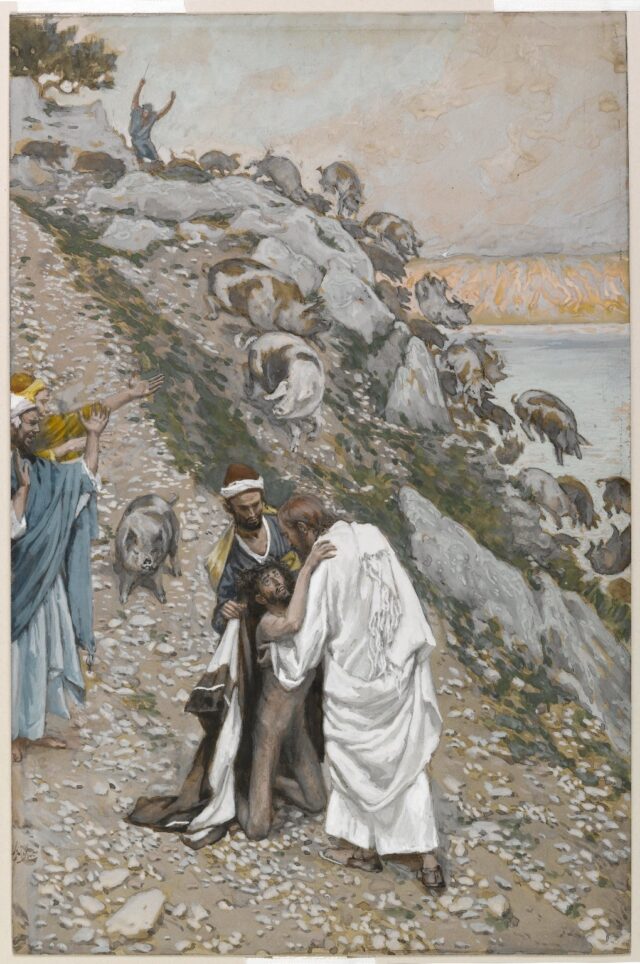
Today, I spent time with the Gerasene demoniac.
At least I did so in my imagination. I journeyed there in prayer and then stood with Jesus, watching the tortured and screaming man descending the hillside and identifying his demons as “legion.”
Praying with the imagination is a hallmark of Ignatian spirituality. It’s an active form of prayer, used in the Spiritual Exercises of St. Ignatius of Loyola, founder of the Jesuits. It’s used particularly when we explore the life of Jesus in Scripture. In Ignatian parlance, it’s called contemplation, but instead of keeping our mind free of thoughts as one would in some forms of contemplative prayer, in the Ignatian tradition the mind, heart, and memory are fully engaged.
Since July 31 is the feast day of St. Ignatius, July — the 31 days of Ignatius — is a wonderful month to take a deep dive into this intimate form of prayer.
The demoniac’s story is one of Scripture’s most captivating. Jesus arrives “on the other side of the sea” (Mk 5: 1), having sailed into pagan territory on the Sea of Galilee, directly across from the Jewish town of Capernaum. We have reached the land of Gerasenes.

Jesus is immediately confronted by a frightening man who emerges from the cave-like tombs among the rocks. A version of this story appears in all three synoptic Gospels, but Mark’s version, which runs to 20 verses, is powerful, simple and direct.
My imagination lets me take in the heat of the day, the oppressive dust, the strangled cries of the tortured man who cannot be restrained, even by chains. As I sink into my imagination, I note my reactions to what is before me. Am I afraid? Instead of standing back, terrified, today I feel great empathy for this tortured man. I feel confident that Jesus has things in hand. I look up in amazement as the man descends the rocky incline towards me.
In Jesuit Father James Martin’s book, “Jesus A Pilgrimage,” he recounts his own journey to Israel and his attempt to find the real sites of many Scripture stories. He devotes an entire chapter to this confrontation with the man besieged by evil spirits, and shares expert opinions on the story and its possible true-life location. With him, you confront an unwelcoming vista where empty tombs sheltered a besieged man. And you are led into prayer.
Jesus knows who the demons are and does not fear them. Instead, they fear him, and ask to be sent into the pigs grazing on the hillside.
In my imagination the pigs feature strongly because I grew up on an old-fashioned family farm with pigs — chickens, milk cows, feral cats — we had them all. Let me tell you that two thousand pigs, which is Mark’s report, is an enormous number of pigs. Can you imagine what that many dead pig carcasses would do to the ecosystem of the Sea of Galilee? Who was counting pigs anyway?
So, in my imagination, there’s a herd of pigs, a realistic number. Praying with my imagination allows me to be creative with the environment. I watch in amazement as Jesus sends the demons into the pigs and into the water.
I feel great compassion for the man possessed. Who of us has not been overtaken by our own failures and sinfulness? Who has not felt alone, rejected? Who has not withdrawn in anger or torn at chains we feel binding us? Demonic possession may be a rare thing, but everyone has suffered from the results of evil in this world.
Tomorrow I’m going back to the hillside to spend more time with the man freed by Jesus. I will ask Jesus to help me with the chains that bind me.
Effie Caldarola is a wife, mom and grandmother who received her master’s degree in pastoral ministry from Seattle University.






